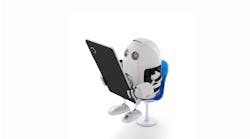Paul Feuerstein, DMD
Attention all techies and software and hardware installers: The Net Integrator, aka the Swiss army knife of networking, has arrived. This product — a PC magazine Editor's Choice, came to my attention late last year. The Net Integrator looks like a large computer, but the similarity ends there. In a nutshell, it's like a robot administrator, which the industry calls a "server appliance." The word appliance implies that it operates by itself, unlike most Windows-based computers. (I can hear the Mac and Unix fans applauding in the background).
Many offices have entered a high level of computer network sophistication, with PCs in treatment rooms, staff areas, labs, and other parts of the office. The setup and management of this type of configuration is usually delegated to an outside consultant or inside person, depending on the size of the office and network. However, in many situations, the dentist has taken the responsibility. Inevitably, system problems occur when the dentist is in the middle of a multi-unit final impression.
This amazing piece of equipment is difficult to explain in lay terms, so please excuse the computer speak. The unit plugs into an existing network hub or switch and then acts as part administrator and part traffic cop. According to PC magazine, "Initial setup and configuration of this device was really a matter of plugging in the cabinet and getting a cup of coffee." During setup, the unit searches throughout the network and identifies all of the computers. It not only directs all of the data traffic, but it can perform system backups as often as every 15 minutes into either of the two standard removable hard drives. If the power went out in the middle of any of its operations, the unit picks up where it left off when power is restored. The owner of the company has been known to literally pull out the plug in the middle of demonstrations to prove this point. If your office depends on an internet connection, the Net Integrator makes sure you are never down. It allows you to be connected to two different network online services simultaneously, uses both for maximum throughput, and will automatically switch over if one drops out. In addition, there is a dialup modem, which will call in if both of those fail.
Remote administration is also quite simple and goes above and beyond products like PCAnywhere. When you connect into the system, you have full access to any computer on the network. There are many more features like VPN, DHCP, DNS, Web and email server capabilities and more. To learn more, visit www.net-itech.com.
While I'm dwelling on hardware, I'll shift back to the audio systems in the office. In a past column, I discussed the problems of Internet music sharing. The RIAA has cracked down and begun litigation that has, at least for now, slowed the system down. Many offices would still like to make CD copies or compilations for their offices, but they don't have a method to copy old vinyl, cassette, or even reel-to-reel tapes without dragging a computer into the living room or running wires all over the house. (Laptops could be an option, although most do not have stereo audio inputs as a standard feature). The solution turns out to be as simple as a trip to Best Buy or Circuit City. There are components available that have two CD bays — both usually play CDs, including mp3 format. One drive is a CD burner. These typically are slow — 2-4x — and the programming is tedious, especially since it is done on a two to three inch screen with primitive software. Having said that, you can "burn" your old records and tapes onto a CD format. One note of caution — you must use CDRs that say "digital audio." Fortunately, these are readily available. If you insist on using your computer, there is a slick little device called the TDL (zianet.com). This is a little preamp that allows you to bring your turntable up to your computer and amplifies the signal so it can be fed right into the computer audio card. I hope to report soon on a new wireless unit that offers another interesting alternative. Keep reading this journal so you can afford these new toys.
Dr. Paul Feuerstein installed one of dentistry's first computers in 1978. For more than 20 years, he has taught courses on technology throughout the country. He is a mainstay at technology sessions, including annual appearances at the Yankee.Dental Congress, and has been a part of the ADA's Technology Day since its inception. A general practitioner in North Billerica, Mass., since 1973, Dr. Feuerstein maintains a Web site (www.computersindentistry.com) and can be reached by email at [email protected].





